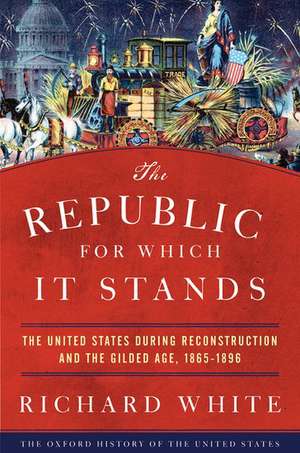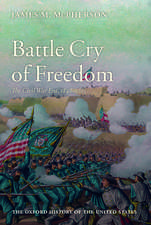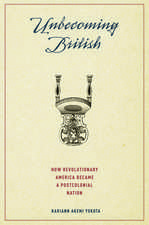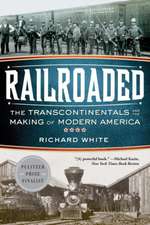The Republic for Which It Stands: The United States during Reconstruction and the Gilded Age, 1865-1896: Oxford History of the United States
Autor Richard Whiteen Limba Engleză Hardback – 26 oct 2017
The Oxford History of the United States is the most respected multivolume history of the American nation. In the newest volume in the series, The Republic for Which It Stands, acclaimed historian Richard White offers a fresh and integrated interpretation of Reconstruction and the Gilded Age as the seedbed of modern America.At the end of the Civil War the leaders and citizens of the victorious North envisioned the country's future as a free-labor republic, with a homogenous citizenry, both black and white. The South and West were to be reconstructed in the image of the North. Thirty years later Americans occupied an unimagined world. The unity that the Civil War supposedly secured had proved ephemeral. The country was larger, richer, and more extensive, but also more diverse. Life spans were shorter, and physicalwell-being had diminished, due to disease and hazardous working conditions. Independent producers had become wage earners. The country was Catholic and Jewish as well as Protestant, and increasingly urban and industrial. The "dangerous" classes of the very rich and poor expanded, and deepdifferences-ethnic, racial, religious, economic, and political-divided society. The corruption that gave the Gilded Age its name was pervasive. These challenges also brought vigorous efforts to secure economic, moral, and cultural reforms. Real change-technological, cultural, and political-proliferated from below more than emerging from political leadership. Americans, mining their own traditions and borrowing ideas, produced creative possibilities for overcoming the crises that threatened their country.In a work as dramatic and colorful as the era it covers, White narrates the conflicts and paradoxes of these decades of disorienting change and mounting unrest, out of which emerged a modern nation whose characteristics resonate with the present day.
| Toate formatele și edițiile | Preț | Express |
|---|---|---|
| Paperback (1) | 190.51 lei 3-5 săpt. | |
| Oxford University Press – 14 noi 2019 | 190.51 lei 3-5 săpt. | |
| Hardback (1) | 191.67 lei 10-16 zile | |
| Oxford University Press – 26 oct 2017 | 191.67 lei 10-16 zile |
Preț: 191.67 lei
Preț vechi: 237.09 lei
-19% Nou
36.68€ • 38.15$ • 30.28£
Carte disponibilă
Livrare economică 13-19 martie
Specificații
ISBN-10: 0199735816
Pagini: 968
Ilustrații: 97 hts
Dimensiuni: 165 x 236 x 58 mm
Greutate: 1.54 kg
Editura: Oxford University Press
Colecția OUP USA
Seria Oxford History of the United States
Locul publicării:New York, United States
Recenzii
(White) is one of the outstanding historians of his generation. It is difficult to think of many others who can match the range, depth, originality and influence of his writings.
When questions of race, economic inequality, and the rise of giant corporate monopolies and a plutocratic elite dominate U.S. politics, it is time to take another look at Reconstruction and the Gilded Age...The rich history of those years (The Industrial Revolution) can be difficult to follow; readers will thank White for the clear prose and strong narrative drive that makes this complicated story easier to understand.
[White] is one of the outstanding historians of his generation. It is difficult to think of many others who can match the range, depth, originality and influence of his writings, which include a prize-winning account of the construction of the transcontinental railroads, an environmental history of the Columbia River Valley, a general history of the American West, and even a memoir of his mothers life as an emigrant from Ireland. White is to be commended for assuming responsibility for this part of the series after more than one historical had abandoned it. His footnotes and bibliography reveal a remarkable command of the historical literature which he uses to construct a vast, sprawling and often original panorama of the American economy, politics and society between 1865 and 1896.
The Republic for Which It Stands is a remarkably fresh and innovative way of looking at the Reconstruction and Gilded Age by an academic with unmatched academic credentials. No matter how much you have read on the Reconstruction and the Gilded Age, The Republic for Which It Stands has a lot to offer you. The Republic for Which It Stands should be a required part of any American history syllabus in all universities.
There is almost nothing about the era that White fails to treat with intelligence and style... Richard White has related a decisive part of its history with stamina and skill.
But most of all Mr White's book should be read -- not just because it has so much to say about the latter part of the 19th century, but also because it casts light on America's current problems with giant companies and roiling populism.
The 10th entry in the series, covering the United States during Reconstruction and the Gilded Age, may be the most erudite and sweeping of them all as well as among the most timely, reminding during a time of turmoil that the divisive tensions of race and class inequities, economic upheaval, and regional schisms have deep, tangled roots.
In this monumental yet highly readable book, Mr. White has given us a panorama of an age that in many ways seems like our own. The volcanic turmoil of the late 19th century did much to shape the world that we live in today, with its creative and destructive cycles of industry, its quickening technological change, its extremes of wealth and poverty, its struggle to impose fairness in the jungle of the marketplace, its tug of war between freedom and regulation in the public interest. The Republic for Which It Stands is, in no small part, the story of how we came to be who we are.
This seminal work is essential reading on the history of the United States.
This splendid history from White (Railroaded), professor of American history at Stanford, reveals why the 30 years after the Civil War do not readily draw historians to them... White's great achievement is to capture the drabbest, least-redeeming three decades of American history with unimpeachable authority.
Fearless and peerless, Richard White leads us through a transformed and fragmented nation in turmoil, haunted by the slain Abraham Lincoln, where visions of freedom and equality were rapidly vanishing. In the rural South, in the urban North, and out West, from the terribly destitute to the stupendously wealthy, White brings together stories that historians have long told separately, untangling the anger and blame that grew so deeply entrenched in the Gilded Age. How did all this happen? Richard White explains everything.

































